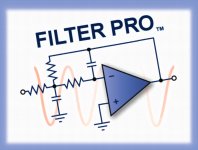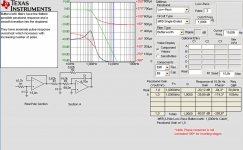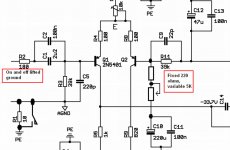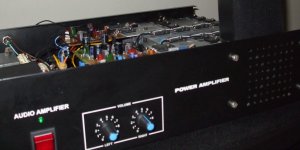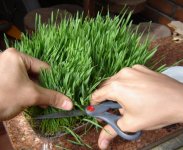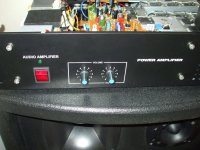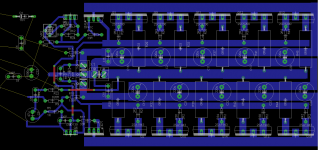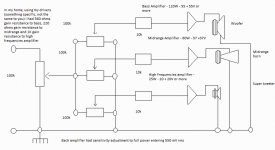A forum friend, made the kindness to send me the software to build
active filters.
Let me know if you want it Gaetan.... around 3 Megabytes.
with the filter i can produce, easier, the active to test if they will sound better...i doubt a lot...but childrens (listening tests) will decide that stuff.
It is Filter Pro from Texas Instruments.
regards,
Carlos
active filters.
Let me know if you want it Gaetan.... around 3 Megabytes.
with the filter i can produce, easier, the active to test if they will sound better...i doubt a lot...but childrens (listening tests) will decide that stuff.
It is Filter Pro from Texas Instruments.
regards,
Carlos
Attachments
Last edited:
Carlos, I don't rate me or you as audiophiles, simply because we listen to music how we like to hear and enjoy it.
Audiophiles listen to the equipment and need to prove to themselves it sould sound nice, but I sometimes don't think that they enjoy music, they enjoy sounds.
Neither of these religions are wrong, one is a little more radical than the other but it is what you believe is right for you.
Audiophiles listen to the equipment and need to prove to themselves it sould sound nice, but I sometimes don't think that they enjoy music, they enjoy sounds.
Neither of these religions are wrong, one is a little more radical than the other but it is what you believe is right for you.
Geatan/Carlos,
don't you think passive filter is better, but adjust the amplifier gain a little to compensate for insertion loss. The losses in a passive filter is only 1 or 2 dB in the passband.
Besides passive filters do not generate noise, active filters does. In my set-up I started with active filters but at high levels I could hear the shhhh during quiet passages.
I changed to passive and adjusted the amp gain 2 dB up and there was no more noise. If you consider noise figure, the first stage is what determines the major noise of the system.
Kindest regards
Nico
don't you think passive filter is better, but adjust the amplifier gain a little to compensate for insertion loss. The losses in a passive filter is only 1 or 2 dB in the passband.
Besides passive filters do not generate noise, active filters does. In my set-up I started with active filters but at high levels I could hear the shhhh during quiet passages.
I changed to passive and adjusted the amp gain 2 dB up and there was no more noise. If you consider noise figure, the first stage is what determines the major noise of the system.
Kindest regards
Nico
I have tested without the 10 ohms ground lift resistance..the lifted ground to the
input signal and i could listen noise too... them i have inserted the resistance back to place...in the reality i have removed the short i have made with wire across the 10 ohms resistance....now the noise reduced a lot..... hard to listen..i have to lift the volume all the way up and go 50 centimeters to the tweeter to listen.
regards,
Carlos
input signal and i could listen noise too... them i have inserted the resistance back to place...in the reality i have removed the short i have made with wire across the 10 ohms resistance....now the noise reduced a lot..... hard to listen..i have to lift the volume all the way up and go 50 centimeters to the tweeter to listen.
regards,
Carlos
Attachments
Last edited:
Noises....i found the noises can be reduced by the lifted ground
but of course, not to producing, not to generating, not to use active may be more interesting.
The lifted ground, by itself can not be the medicine to noises..better not to generate them, not to produce them, not to use active devices, better go avoiding extra stages and so on.
You have agreement...i do not listen music.... i use to listen sound...also i play guitar but i do not know if Do, or Mi, or other tone...i just play the sound.
regards,
Carlos
but of course, not to producing, not to generating, not to use active may be more interesting.
The lifted ground, by itself can not be the medicine to noises..better not to generate them, not to produce them, not to use active devices, better go avoiding extra stages and so on.
You have agreement...i do not listen music.... i use to listen sound...also i play guitar but i do not know if Do, or Mi, or other tone...i just play the sound.
regards,
Carlos
Attachments
Geatan/Carlos,
don't you think passive filter is better, but adjust the amplifier gain a little to compensate for insertion loss. The losses in a passive filter is only 1 or 2 dB in the passband.
Besides passive filters do not generate noise, active filters does. In my set-up I started with active filters but at high levels I could hear the shhhh during quiet passages.
I changed to passive and adjusted the amp gain 2 dB up and there was no more noise. If you consider noise figure, the first stage is what determines the major noise of the system.
Kindest regards
Nico
Hello Nico
Yes passive filter is better since no op-amp are in the signal path.
But somes passive filters can have phase anomalies problems and could be hard to get flat response.
Bye
Gaetan
active filters.
Let me know if you want it Gaetan.... around 3 Megabytes.
with the filter i can produce, easier, the active to test if they will sound better...i doubt a lot...but childrens (listening tests) will decide that stuff.
It is Filter Pro from Texas Instruments.
regards,
Carlos
Hello Carlos
Thank, I did go at ti.com and there I did found Filter Pro.
I did have an old version of op-amp filter calculation but Filter Pro are better.
Bye
Gaetan
Last edited:
...we have to take that drink around the swiming pool....do you remember?
hahaha you are right Carlos, and very good memory too, it's true we have to take that drink someday around the swimming pool with dancing chikas and Sangria, and when the Sangria is finished we will continue with Caipirinha until the sunrise...
 and your 3-channel amplifier tuned in with love will play Samba and Bossa Nova all night long, and after the party is over we will go inside and tweak the amplifier with more love for next night session!! hehehe
and your 3-channel amplifier tuned in with love will play Samba and Bossa Nova all night long, and after the party is over we will go inside and tweak the amplifier with more love for next night session!! hehehe
You know I was thinking about those CCS or resistors for the input differential stage, I was reminded once thinking I would use a huge resistor value and connect it to 1000 Volts source, actually I posted the idea here for a long time ago, I must one day try that crazy and dangerous idea! hehe
Cheers Michael
PS: If I come to Rio de Janeiro 2016 or another year I promise we will meet!
heheheheh that's fine.
We gonna be waiting for you all folks, in Rio 2016...i promise and guarantee you will visit the second most pretty place in this world (first is Honolulu in Hawai)
Well...people say the world will finish in 2012..... december 22 i think, not sure..the Maya and Aztec calendar shows that day as beeing the last one.
We do not bother about what Maya and Aztec said.... their world already finished 500 years ago.... our world will finish, maybe drowned, because too much beer during the 2016 Olympic games.... people may have heart attack watching the girls passing by while sitted at Copacabana beach having beer and roasted sausages (wurst unt bratwurst, frite potatoes, sausage with onions and bread and baked frited provolone cheese and also some Calabrian sausage from Italy)...yessssss!
My memory is even better than the elefant's memory..sometimes they asked me things they forgot...mum gave me some medicine made using Cod liver oil when i was very young...i remember details while i was 3 years old and television advertising gingles from the fifties.
The 2016 Olympic games celebration vídeo drives me happy listening our drums...they are part of our Afro-american culture... those things are part of our genetic.
Cheers!
Hic!
Carlos
We gonna be waiting for you all folks, in Rio 2016...i promise and guarantee you will visit the second most pretty place in this world (first is Honolulu in Hawai)
Well...people say the world will finish in 2012..... december 22 i think, not sure..the Maya and Aztec calendar shows that day as beeing the last one.
We do not bother about what Maya and Aztec said.... their world already finished 500 years ago.... our world will finish, maybe drowned, because too much beer during the 2016 Olympic games.... people may have heart attack watching the girls passing by while sitted at Copacabana beach having beer and roasted sausages (wurst unt bratwurst, frite potatoes, sausage with onions and bread and baked frited provolone cheese and also some Calabrian sausage from Italy)...yessssss!
My memory is even better than the elefant's memory..sometimes they asked me things they forgot...mum gave me some medicine made using Cod liver oil when i was very young...i remember details while i was 3 years old and television advertising gingles from the fifties.
The 2016 Olympic games celebration vídeo drives me happy listening our drums...they are part of our Afro-american culture... those things are part of our genetic.
Cheers!
Hic!
Carlos
Attachments
Last edited:
Dx Corporation offers you a flat sound (to your ears) into a unflat system
You will no more worry about speaker efficiency
You will no more worry about enclosure tuning
You will no more worry about your home acoustics
You will no more worry about your ears, if flat or not flat
The Dx Corporation offers you the simple, cheap and fast way to adjust the whole thing to be "good to you".... to make your home good in acoustics...to make your ears good to listen and to make your listening always pleasant despite the bad recordings we have around.
You can adjust, or technically misadjust the whole thing to allow you to feel things good.
Do not matter what instruments will measure..you are not playing music for them..hell to them!
Be happy..use Dx TriAmp system.... and use it with the amplifier you have..ALL THEM WILL BE GOOD....the idea, the system, is bigger than the amplifiers quality.... high quality is not even needed..distortion is lower because the system, because the idea by itself.
Number-0-logists, calculators, high complexity stuff designers..all them have lost their jobs...they are in front of the Corporation asking for job....i will give them tools to cut the grass..... i am bad!...baaaaad!
There are 5 acres in front of the corporation..all grass...i want a precise cut, tollerance will be 1 milimeter plus or minus..they like numbers..so they will have numbers to worry themselves....and i will provide tools..watch the picture!
ahahahahahah!
Carlos
You will no more worry about speaker efficiency
You will no more worry about enclosure tuning
You will no more worry about your home acoustics
You will no more worry about your ears, if flat or not flat
The Dx Corporation offers you the simple, cheap and fast way to adjust the whole thing to be "good to you".... to make your home good in acoustics...to make your ears good to listen and to make your listening always pleasant despite the bad recordings we have around.
You can adjust, or technically misadjust the whole thing to allow you to feel things good.
Do not matter what instruments will measure..you are not playing music for them..hell to them!
Be happy..use Dx TriAmp system.... and use it with the amplifier you have..ALL THEM WILL BE GOOD....the idea, the system, is bigger than the amplifiers quality.... high quality is not even needed..distortion is lower because the system, because the idea by itself.
Number-0-logists, calculators, high complexity stuff designers..all them have lost their jobs...they are in front of the Corporation asking for job....i will give them tools to cut the grass..... i am bad!...baaaaad!
There are 5 acres in front of the corporation..all grass...i want a precise cut, tollerance will be 1 milimeter plus or minus..they like numbers..so they will have numbers to worry themselves....and i will provide tools..watch the picture!
ahahahahahah!
Carlos
Attachments
Last edited:
Those guys are boring..always searching for our mistakes to say:
- Hey Dx!...it is not 30 watts.... wrong!..... correct power is 29.998W.
Will give them something usefull to do into the Corporation...to take care of the garden, to cut grass!
This one is the first.... this boring one was from Portugal.
ahahahah!... having fun, of course.... calculators are usefull (sometimes)
regards,
Carlos
- Hey Dx!...it is not 30 watts.... wrong!..... correct power is 29.998W.
Will give them something usefull to do into the Corporation...to take care of the garden, to cut grass!
This one is the first.... this boring one was from Portugal.
ahahahah!... having fun, of course.... calculators are usefull (sometimes)
regards,
Carlos
Attachments
Dx triamp bass unit pcb construction has been started..
by Dx corporation.
im giving a try to design the bass unit pcb. Its a big project to me there will be many corrections to be done.. never mind at least im trying.. ill be happy in the end
there will be many corrections to be done.. never mind at least im trying.. ill be happy in the end 
regards,
Ranga
by Dx corporation.
im giving a try to design the bass unit pcb. Its a big project to me

regards,
Ranga
Attachments
It is normal, and natural, to have errors...to avoid them we have to work too much
slow..... if we give to ourselves 6 monthes of dead line, them no failure will happens because we will be checking so many times that before the first power on, all mistakes would be detected and corrected...so...failures happens same way, but the long therm dead line will be enougth to find them all.
I use to build.... including the fast board production, in less than 5 hours.... because of that, usually i made mistakes...that result in more 2 hours to find them...even this way is better than 6 monthes of dead line...in six monthes i can assemble from 180 to 210 amplifiers (single channels).
Doing fast become ugly...there are losses to be fast...beeing fast we use to be a pig too.
TIP42 and TIP41, also BD139 has voltage limits....so...maximum voltage is 42 plus 42 volts to use them...to use 62 volts or something higher you must substitute them to 2SA1837 (when PNP) and 2SC4793 (when NPN) , or other that can face the peak to peak voltage (rail to rail voltage.... rail plus rail voltage).
Several can be used.... 5 watts dissipation to the VAS and 10 watts dissipation to the drivers...and this, almost all transistors (to220) can face.
regards,
Carlos
slow..... if we give to ourselves 6 monthes of dead line, them no failure will happens because we will be checking so many times that before the first power on, all mistakes would be detected and corrected...so...failures happens same way, but the long therm dead line will be enougth to find them all.
I use to build.... including the fast board production, in less than 5 hours.... because of that, usually i made mistakes...that result in more 2 hours to find them...even this way is better than 6 monthes of dead line...in six monthes i can assemble from 180 to 210 amplifiers (single channels).
Doing fast become ugly...there are losses to be fast...beeing fast we use to be a pig too.
TIP42 and TIP41, also BD139 has voltage limits....so...maximum voltage is 42 plus 42 volts to use them...to use 62 volts or something higher you must substitute them to 2SA1837 (when PNP) and 2SC4793 (when NPN) , or other that can face the peak to peak voltage (rail to rail voltage.... rail plus rail voltage).
Several can be used.... 5 watts dissipation to the VAS and 10 watts dissipation to the drivers...and this, almost all transistors (to220) can face.
regards,
Carlos
I was tweaking the gain trimpot today..and i found the following values
360 ohms to the bass amplifier
220 ohms to the midrange amplifier
995 ohms to the treble amplifier (1K is good too)
The best idea is to install good quality trimpots there...to have easier adjustment.
To the bass amplifier use 100 ohms fixed resistance in series with a 500 ohms trimpot adjusted to 260 ohms...so..near half way.
To the midrange amplifier use 120 ohms fixed resistance in series with a 200 ohms trimpot adjusted to 100 ohms...so...near half way gone.
To the treble amplifier use 560 ohms resistance in series with a 1K trimpot, adjusted to 440 ohms...so, almost half way into the adjustment..the midway point.
regards,
Carlos
360 ohms to the bass amplifier
220 ohms to the midrange amplifier
995 ohms to the treble amplifier (1K is good too)
The best idea is to install good quality trimpots there...to have easier adjustment.
To the bass amplifier use 100 ohms fixed resistance in series with a 500 ohms trimpot adjusted to 260 ohms...so..near half way.
To the midrange amplifier use 120 ohms fixed resistance in series with a 200 ohms trimpot adjusted to 100 ohms...so...near half way gone.
To the treble amplifier use 560 ohms resistance in series with a 1K trimpot, adjusted to 440 ohms...so, almost half way into the adjustment..the midway point.
regards,
Carlos
Last edited:
One more image explaining how i have made
The input potentiometer is the Master Volume....increase and decrease bass, mids and treble...something we have into the PC output, the master level...also we have into CD and DVD players, the output volume control.
Then you have bass control, midrange control and treble control...each one of them going to their bandwidth amplifiers, and they go to drivers designed to that bandwidth....no capacitor...direct coupled.
I have made into the ratio, proportion, of 60 percent for bass, 30 percent for midrange and 10 percent for high frequencies (treble).
All amplifiers reach the maximum power when you enter 550 milivolts RMS into the power amplifier input, of course, the center frequency the amplifier is able to amplify..... 100 hertz to bass, 2 Kilohertz to Mids and 6 Kilohertz to high frequencies.
The midrange amplifier can reproduce 200 hertz, also bellow with losses, and some voices have frequencies in this range...good to use a traditional 6 inches driver to reproduce voices, not only the horn one...in this case, use a capacitor to the horn to limit frequency (high midranges to the horn) and direct connection to the full range, 6 inches speaker.
The gain trimpot, already shown in this same thread, was adjusted the way informed...but you may have differences because your drivers and the amplifiers you have choosen to do the TriAmp..... because of that the trimpots are there, to adjust each case.
This way...entering signal that gonna be attenuated by the fixed resistances and potentiometers, having full drive to each amplifier... and panel potentiometers (bass, mids and treble) into the midway position..then you will have something alike the flat equalization response.... AND...the potentiometers are there to correct to each musical style, specific music, taste, home acoustics and so on.
Be happy!...it is working..... working fine...working great.
Standard amplifiers, reproducing full range...full audio bandwidth, cannot reproduce with the quality i am having here...i can beat all them...no doubts about that...not because my amplifier quality..but because the IDEA, the Triple amplifier system.
Tetra amplifier may be better, for sure...reducing bandwidth to each amplifier sounds much better.
regards,
Carlos
The input potentiometer is the Master Volume....increase and decrease bass, mids and treble...something we have into the PC output, the master level...also we have into CD and DVD players, the output volume control.
Then you have bass control, midrange control and treble control...each one of them going to their bandwidth amplifiers, and they go to drivers designed to that bandwidth....no capacitor...direct coupled.
I have made into the ratio, proportion, of 60 percent for bass, 30 percent for midrange and 10 percent for high frequencies (treble).
All amplifiers reach the maximum power when you enter 550 milivolts RMS into the power amplifier input, of course, the center frequency the amplifier is able to amplify..... 100 hertz to bass, 2 Kilohertz to Mids and 6 Kilohertz to high frequencies.
The midrange amplifier can reproduce 200 hertz, also bellow with losses, and some voices have frequencies in this range...good to use a traditional 6 inches driver to reproduce voices, not only the horn one...in this case, use a capacitor to the horn to limit frequency (high midranges to the horn) and direct connection to the full range, 6 inches speaker.
The gain trimpot, already shown in this same thread, was adjusted the way informed...but you may have differences because your drivers and the amplifiers you have choosen to do the TriAmp..... because of that the trimpots are there, to adjust each case.
This way...entering signal that gonna be attenuated by the fixed resistances and potentiometers, having full drive to each amplifier... and panel potentiometers (bass, mids and treble) into the midway position..then you will have something alike the flat equalization response.... AND...the potentiometers are there to correct to each musical style, specific music, taste, home acoustics and so on.
Be happy!...it is working..... working fine...working great.
Standard amplifiers, reproducing full range...full audio bandwidth, cannot reproduce with the quality i am having here...i can beat all them...no doubts about that...not because my amplifier quality..but because the IDEA, the Triple amplifier system.
Tetra amplifier may be better, for sure...reducing bandwidth to each amplifier sounds much better.
regards,
Carlos
Attachments
thank you for saving my time...
I substituted the transistors to 2SA1837 and 2SC4793. I appreciate if someone can mark wattage of each resistor other than 0.25W on the schematic and the voltage of each capacitor which are higher than Dx standard. That will help me to select the right component sizes. I have attached my schematic with this. feel free to make corrections on it
thanks and best regards,
Ranga
I substituted the transistors to 2SA1837 and 2SC4793. I appreciate if someone can mark wattage of each resistor other than 0.25W on the schematic and the voltage of each capacitor which are higher than Dx standard. That will help me to select the right component sizes. I have attached my schematic with this. feel free to make corrections on it
thanks and best regards,
Ranga
Attachments
Also inform the schematic you gonna use..there are some modifications
There are differences, the bass amplifier to TriAmp system is different compared to other Dx Amplifier made to 55V or 62V.... there are modifications into currents, and as a consequence, there are differences in resistance wattage.
Measure your supply voltage under load... the voltage under load is the voltage you will measure while sucking energy from both rails at the same time..something alike to install 2 resistances of 15 ohms and 20 watts (do the test fast or resistances will smoke) installed one from positive to ground and other from negative to ground and measuring (do it fast and fast switch your supply off) the voltage under load..almost 4 amperes each rail...we gonna see evaluating by the voltage drop how your supply will behave.... and them we can decide, with more precision, the power transistor needs (quantity), the heatsink size, and also resistance watts under real hard use conditions.
Of course you can find a 300 watts resistance..but this will be very expensive..so, use the smaller ones (15 watts, 20 watts, 50 watts) and do the test fast, as you gonna have 250 watts or more into each rail.
You can decide resistance wattage into stand by condition and also you can evaluate under hard use... a more real voltage reference is under hard use... this way we gonna see how big will be the resistances related power dissipation, or if you can keep 1/4 watt.
Under use, different than the stand by current, you have the AC current, that is the modulated DC current you had before you have injected audio into your amplifier... there are variations of current and voltage that you measure as root means square (rms) voltage.
regards,
Carlos
There are differences, the bass amplifier to TriAmp system is different compared to other Dx Amplifier made to 55V or 62V.... there are modifications into currents, and as a consequence, there are differences in resistance wattage.
Measure your supply voltage under load... the voltage under load is the voltage you will measure while sucking energy from both rails at the same time..something alike to install 2 resistances of 15 ohms and 20 watts (do the test fast or resistances will smoke) installed one from positive to ground and other from negative to ground and measuring (do it fast and fast switch your supply off) the voltage under load..almost 4 amperes each rail...we gonna see evaluating by the voltage drop how your supply will behave.... and them we can decide, with more precision, the power transistor needs (quantity), the heatsink size, and also resistance watts under real hard use conditions.
Of course you can find a 300 watts resistance..but this will be very expensive..so, use the smaller ones (15 watts, 20 watts, 50 watts) and do the test fast, as you gonna have 250 watts or more into each rail.
You can decide resistance wattage into stand by condition and also you can evaluate under hard use... a more real voltage reference is under hard use... this way we gonna see how big will be the resistances related power dissipation, or if you can keep 1/4 watt.
Under use, different than the stand by current, you have the AC current, that is the modulated DC current you had before you have injected audio into your amplifier... there are variations of current and voltage that you measure as root means square (rms) voltage.
regards,
Carlos
Last edited:
- Status
- This old topic is closed. If you want to reopen this topic, contact a moderator using the "Report Post" button.
- Home
- Amplifiers
- Solid State
- Dx TriAmp bass unit
